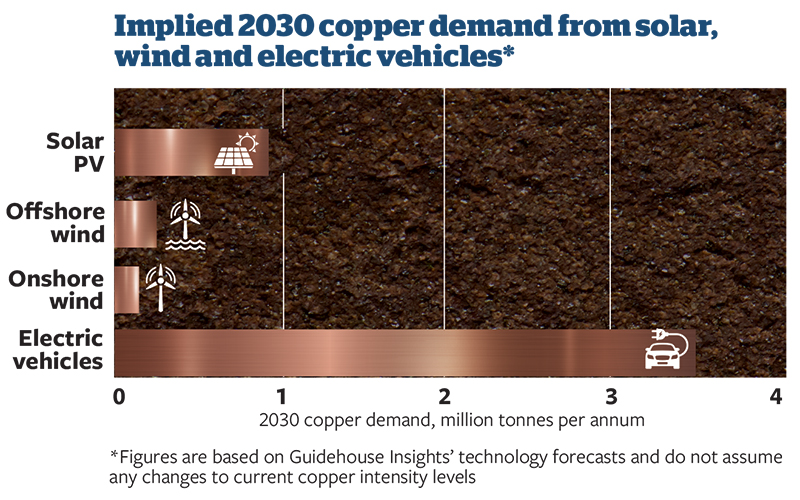Will copper shortages delay energy transition?
Copper is essential for most of the clean energy technologies we will rely on in future, so a sustainable and secure supply of copper is vital to realise the full benefits of the energy transition. Jacques Moss at Guidehouse Insights asks: can copper supply keep up?

The world is moving towards a future with higher levels of renewable energy generation and more extensive electrification of final energy demand. A changing energy system will lead to a radically altered balance of material flows, with fewer fossil fuels and more of the mineral inputs needed to make electrification happen at scale.
From a materials perspective, copper will be the single largest contributor to this shift in energy production and consumption. Global copper production currently stands at 21m tonnes per year. Besides silver, it is the most conductive metal on the periodic table, and offers other benefits such as high pliability, corrosion resistance and tensile strength.
These properties mean that it is used extensively across clean energy technologies. According to the International Copper Association, manufacturing the average passenger electric vehicle (EV) requires 83kg of copper – roughly four times more than is used within internal combustion engine vehicles.
Offshore wind farms currently need 4.9 tonnes of copper for every megawatt installed, and solar PV installations need 2.3 tonnes. Copper is also intrinsic to the build-out of electricity infrastructure required to support electrification, from distribution networks through to transformers and EV charging stations.
A looming supply shortage
Copper’s ubiquity in cleantech manufacturing has prompted concerns of a looming supply shortage as EV and renewable energy deployments ramp up. The International Energy Agency estimates that US$240–300bn of investment in new copper mines will be required by 2030 to place the global economy on a trajectory consistent with net-zero targets. There is currently little evidence that this is occurring, with the mining sector yet to emerge from a 10-year investment downcycle.
The outlook is not all negative, though. For instance, the earth’s crust contains enough copper to satisfy even the most aggressive long-term demand projections. The United States Geological Survey’s most recent estimate places identified and undiscovered copper resources at a combined 5.6bn tonnes, equivalent to two and a half centuries of usage at current demand levels.
Secondly, there is no lack of precedents demonstrating that given enough time, the basic economics of extractive industries will cause production capacity to increase in response to new sources of demand.

Thirdly, technological improvements can help to drive down the copper intensity of clean energy technologies and open up previously uneconomic resources for extraction.
Now for the challenges. Chief among these is the speed of the required scale-up. Development of a new copper mine from resource discovery to completion takes at least 15 years. Along the way, developers need to contend with a range of issues including permitting, local resistance and the management of environmental impacts.
As for reductions in copper intensity, opportunities are highly application specific. Substitution with aluminium is the most common solution, but there are hard limits to the kinds of applications in which aluminium can play a role without incurring serious performance penalties. For instance, aluminium has already largely supplanted copper in high-voltage transmission lines, but EV buyers should not expect to see it used in electric motor windings any time soon.
The geographic concentration of copper production and processing capacity is a further challenge. China plays a leading role in both – it is the world’s third largest copper ore producer and possesses close to half of global refining and smelting capacity – increasing the risk of supply chain disruptions as the transition accelerates.
Newfound focus on critical mineral security in the US and Europe offers some indications of positive change
Tackling the copper supply challenge
Reducing the risks posed by copper supply constraints will require a combination of ambitious policy measures and industry collaboration. On the policy side, a newfound focus on critical mineral security in the US and Europe offers some indications of positive change.
Both the Inflation Reduction Act and the recently announced Green Deal Industrial Plan include significant provisions aimed at securing critical mineral supply chains. Attention should be paid to improving material recovery rates and fast-tracking mine development processes where it is feasible to do so.
It should also be noted that mining is itself a major emissions source. This problem is being exacerbated by declining copper ore grades, which means that the energy required to extract every ton of usable material is rising. Alongside investing in new mining capacity, copper producers will need to make significant investments in low carbon processes and equipment over the coming decades. Achieving this will require end users to bear a share of the costs through purchasing commitments for copper sources with lower carbon intensities.
At every stage of the cleantech supply chain, solving scale-up challenges and delivering emissions reductions necessitates clear demand signals. For end-users in the energy sector, the priorities should be moving quickly to establish and deliver on long-term material sourcing strategies, as well as collaborating with suppliers to address investment deficits.
By Jacques Moss, Research Analyst, Guidehouse Insights
Image credit | Shutterstock






Follow us
Advertise
Free e-Newsletter